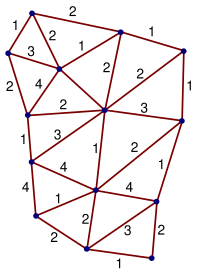自旋网络
量子力学中,自旋网络是一种图表,用以表示粒子与量子场之间的的相互作用与状态。以数学的出发点来看,这些图案是一种简明方法,可代表多线性函数以及矩阵群众多表示之间的关联函数。此图案记号往往能简化计算,以其能代表复杂的函数。自旋网络的发明一般是归因于罗杰·彭罗斯于1971年的贡献,[1]然而在此之前已有类似的图样方法。

透过卡洛·罗威利, 李·斯莫林、霍尔黑·普林, 罗多佛·甘比尼等多位研究者的努力,自旋网络被用于量子引力理论。自旋网络亦可被用在数学中局域规范变换不变性的连通空间,用以建构特定的泛函。
彭罗斯原始定义
编辑1971年,罗杰·彭罗斯提出一种图形表示法,其中每个线段代表一个“单元”(基本粒子或粒子的复合系统)之世界线。三条线段汇聚在一个顶点。顶点可以诠释为一个事件;在此事件中,一个单元分裂成两个单元,或两个单元碰撞合而为一。当一图表中所有的线段都在顶点会合,则此图为“封闭自旋网络”。时间以单一方向行进,比如从图的底部走到图的顶部。然而在封闭自旋网络的例子,时间行进的方向对于计算不构成影响。
每一线段标上一个称作自旋量子数的整数。带有自旋数n的一个单元称作n-单元,其角动量为nħ,ħ是约化普朗克常数。光子、胶子等玻色子,其n为偶数;电子、夸克等费米子,其n为奇数。
给定一封闭自旋网络,则可计算出一个相应的非负整数的范数(norm)。范数可用来计算不同自旋值的概率。当一个自旋网络的范数是零,则其发生概率为零。当范数不为零时,在顶点处则有一些约束条件如下:
若有三个单元会合在一顶点,这三单元分别带有自旋量子数a、b、c,则必须满足
- 三角不等式:a必须小于或等于b + c,b必须小于或等于a + c,以及c必须小于或等于a + b。
- 费米子守恒(Fermion conservation):a + b + c必须是偶数。
举例来说,a = 3, b = 4, c = 6的例子是不可能,因为3 + 4 + 6 = 13是奇数。a = 3, b = 4, c = 9也不可能,因为3 + 4 < 9。而a = 3, b = 4, c = 5则可行,因为3 + 4 + 5 = 12是偶数且满足三角不等式。
一些标记习惯会将整数标为半整数,约束条件则变成a + b + c的和要是整数。
参考资料
编辑参考文献
编辑Early papers:
- Sum of Wigner coefficients and their graphical representation, I. B. Levinson, ``Proceed. Phys-Tech Inst. Acad Sci. Lithuanian SSR 2, 17-30 (1956)
- Applications of negative dimensional tensors, Roger Penrose, in Combinatorial Mathematics and its Applications, Academic Press (1971)
- Hamiltonian formulation of Wilson's lattice gauge theories, John Kogut and Leonard Susskind, Phys. Rev. D 11, 395–408 (1975)
- The lattice gauge theory approach to quantum chromodynamics, John B. Kogut, Rev. Mod. Phys. 55, 775–836 (1983) (see the Euclidean high temperature (strong coupling) section)
- Duality in field theory and statistical systems, Robert Savit, Rev. Mod. Phys. 52, 453–487 (1980) (see the sections on Abelian gauge theories)
Modern papers:
- Spin Networks and Quantum Gravity, Carlo Rovelli and Lee Smolin, Physical Review D 53, 5743 (1995); gr-qc/9505006.
- The dual of non-Abelian lattice gauge theory, Hendryk Pfeiffer and Robert Oeckl, hep-lat/0110034.
- Exact duality transformations for sigma models and gauge theories, Hendryk Pfeiffer, hep-lat/0205013.
- Generalized Lattice Gauge Theory, Spin Foams and State Sum Invariants, Robert Oeckl, hep-th/0110259.
- Spin Networks in Gauge Theory, John C. Baez, Advances in Mathematics, Volume 117, Number 2, February 1996, pp. 253–272.
- Quantum Field Theory of Many-body Systems – from the Origin of Sound to an Origin of Light and Fermions, Xiao-Gang Wen, [1]. (Dubbed string-nets here.)
- A Spin Network Primer, Seth A. Major, American Journal of Physics, Volume 67, 1999, gr-qc/9905020.
- Pre-geometry and Spin Networks. An introduction. [2].
Books:
- Diagram Techniques in Group Theory, G. E. Stedman, Cambridge University Press, 1990
- Group Theory: Birdtracks, Lie's, and Exceptional Groups, Predrag Cvitanović, Princeton University Press, 2008, http://birdtracks.eu/ (页面存档备份,存于互联网档案馆)
外部链接
编辑- (英文)约翰·贝兹于加州大学河滨分校数学系网页—Penrose on Spin Networks (页面存档备份,存于互联网档案馆)
- (英文)Seth A. Major—A Spin Network Primer (页面存档备份,存于互联网档案馆)